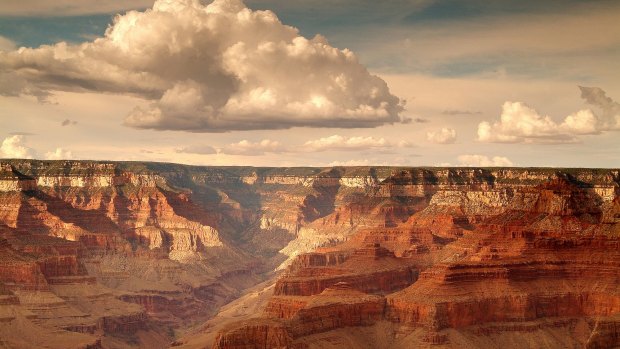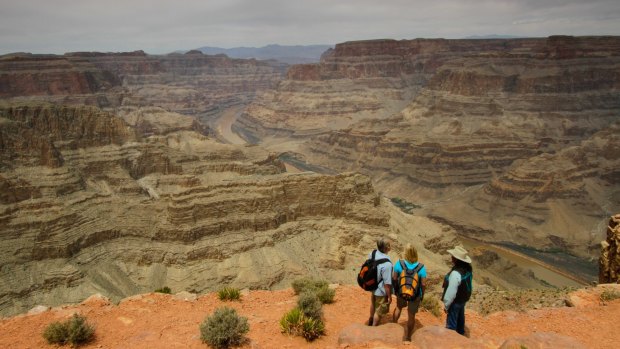This was published 4 years ago
Grand Canyon hikes to the bottom: See the natural wonder without the crowds

The Grand Canyon can be hard to adequately surmise, but if you imagine a jelly-cast for a mountain range then you are part of the way there.
More than 6.4 million tourists – almost the population of Victoria – visit the Grand Canyon National Park every year, but it only requires a few side steps to find peace and quiet. This geological miracle celebrated 100 years as part of the National Park Service in 2019, but to arrive at the South Rim is to see that such designations seem a little silly. What's 100 years compared with something so spectacular?
t's no surprise millions of tourists, both domestic and foreign, want to come for a look. However, more than 95 per cent choose to merely gaze over its considerable edge, meaning if you even begin to head down into its deep belly, towards the Colorado River, the crowds evaporate.
That's where I find myself now, at the very start of the South Kaibab Trail, nervously swapping pavement for dirt path at the start of one of the Grand Canyon's more gruelling routes. Or will it be gruelling? Trekking inside these epic walls is unusual in how uniform it is. There are no undulations and very few plateaus; there is one considerable down, and then an almost unimaginable up.

Hikers are often ill-prepared for facing the canyon's climate.
"Because of this unusual landscape, one of our big successes is our preventative search and rescue program," says park ranger Kristen Luetkemeier.
The idea is that rangers and other park officials are strategically placed along the South Kaibab and Bright Angel trails, to identify potentially problematic hikers. The officials look for signs that trekkers are not physically ready for the exertion – down is, after all, considerably less exhausting than up – or that they're overdressed or, most commonly, because they aren't carrying enough water.
"A lack of preparedness can cause problems for sure," says Luetkemeier. "You can't really take too much food or water, because you might meet someone along the way, you might need to share."
As well as the intimidating gradient of the trails, Arizona's climate can be notoriously inhospitable. Look in many of the state's tourist shops and you'll see assorted souvenirs featuring a skeleton, slumped against some bygone hacienda with the quote, "It's a dry heat."
Temperatures in summer easily sail past 40 degrees, and that's also when the majority of tourists arrive. This is understandably a concern for guides because the majority of search and rescue missions are related to dehydration and exhaustion, rather than dramatic falls from the canyon's edge or unhappy encounters with rattlesnakes.
I'm here in May to avoid the worst of the heat, but to avoid the winter, too. Ordinarily, May would be one of the best months to visit. But climactically, 2019 is anything but normal and so as I head to the edge of the canyon with my friend Robbie McInroy, I am astonished to see snowflakes resting on our shoulders like gentle birds.
In the past my visits have revealed the world's most spectacular fissure to almost glow with a pallette of ochre, vermillion and a light yellow the colour of scrambled eggs. When the sun sets in a place like that, the colours become all the more psychedelic. This is more or less how I'd marketed the Grand Canyon experience to Robbie and so while we'd started the day dousing ourselves in sunscreen, as we make our way to the start of the South Kaibab Trail, we know we've signed up for something different.
Not deterred we plunge down the path. The few faces we see coming the other way look decidedly discontented, and not just because of the dusting of snow. Evidently not impressed by the cooler temperatures, most of the returning hikers look tired and miserable. One dark-haired girl wearing a T-shirt saying: "You Can't Make Everyone Happy – You're Not An Avocado" looks like she might cry. Further down the trail, a portly man in his 40s holds on to the path's rough-hewn wall as though it might offer emotional as well as physical support.
Aside from the relentlessness of their climb, part of their problem is that they have turned their back on the canyon, meaning they are no longer compensated by its magnificence. The scale of the Grand Canyon can be hard to adequately surmise, but if you imagine a jelly-cast for a mountain range then you are part of the way there.
The first Europeans to lay eyes on this astonishing site – red mountains beyond mountains, entire weather systems contained within the canyon's mighty walls – were Spaniards. They were brought here by Hopi tribesmen who, through a series of bad translations, understood only that the Spaniards were searching for something miraculous. Almost certainly they were looking for their fabled El Dorado, but as Robbie and I look out from the excellently named Ooh Aah Point, it's hard to imagine the conquistadors would have been disappointed with this sight.
Much more disappointing today is a lone teenager, obnoxiously playing abysmal pop from a cheap speaker. As he passes, Robbie loudly comments that it "sounds like a fight in a Greek restaurant" and not for the first time, I'm glad his Scottish accent is so thick as to not be understood.
The snow soon swaps to hail the size of peas, which rattles on our hoods like an intolerable upstairs neighbour. "Summer in Arizona, you said," whines my travel companion. "A dry heat, you said."
Underfoot, the iron-rich path turns the colour of tea with not enough milk. It is slippery in places and as we descend further, I am relieved that so many people are self-regulating by not following our route.
"When you come to Grand Canyon, the main thing to remember is that it is still is a national park – a wild place," ranger Ty Karlovetz had told me back at the visitor's centre. "When people come and see some of the animals, they need to remember they're not domesticated animals. They can bite. They can carry fleas and ticks. Sometimes they can behave unpredictably, especially if they've just given birth or have entered the breeding season."
We don't see much fauna on the way down, other than a couple of ground squirrels, but Ty had warned me that they can be the most menacing of all. "The ones who tend to injure the most visitors are actually the squirrels," said the Texan. "Right behind them are elk, which we find near the hotels, along the canyon, in the car parks. They can be super protective of their babies."
In the meantime, I'm being super protective of my knees as the path becomes less and less reliable. This is in direct contrast to the views, which improve as they go on. Like an HBO series, they may have been unsatisfying at the start, but now at the Cedar Ridge and then 45 minutes later at Skeleton Point, they're beyond comprehension.
The Hopi believe that this is the place of their emergence, their own Garden of Eden, and gazing along its impossibly dramatic interior, it certainly does feel transcendent.
Robbie and I don't have time to go all the way to the bottom of the Canyon, and haven't booked the scarce accommodation down there, even if we could beat the sunset. Instead we take our last photos and a couple of deep breaths, before turning for the great climb.
We know we'll bicker as our hearts pump slightly too much blood into our heads, but we know too that we'll never forget this experience, hail and all.
TRIP NOTES
American Airlines flies daily to Phoenix from Sydney and Melbourne via Los Angeles. From there, the park is a three-hour drive north. Like all of America's best national parks, Grand Canyon is best accessed by car. See aa.com; rentalcars.com
TREK
The National Park Service provides information about trekking the South Kaibab or Bright Angel trails, as well as accommodation options and permits . See nps.gov
Sign up for the Traveller Deals newsletter
Get exclusive travel deals delivered straight to your inbox. Sign up now.